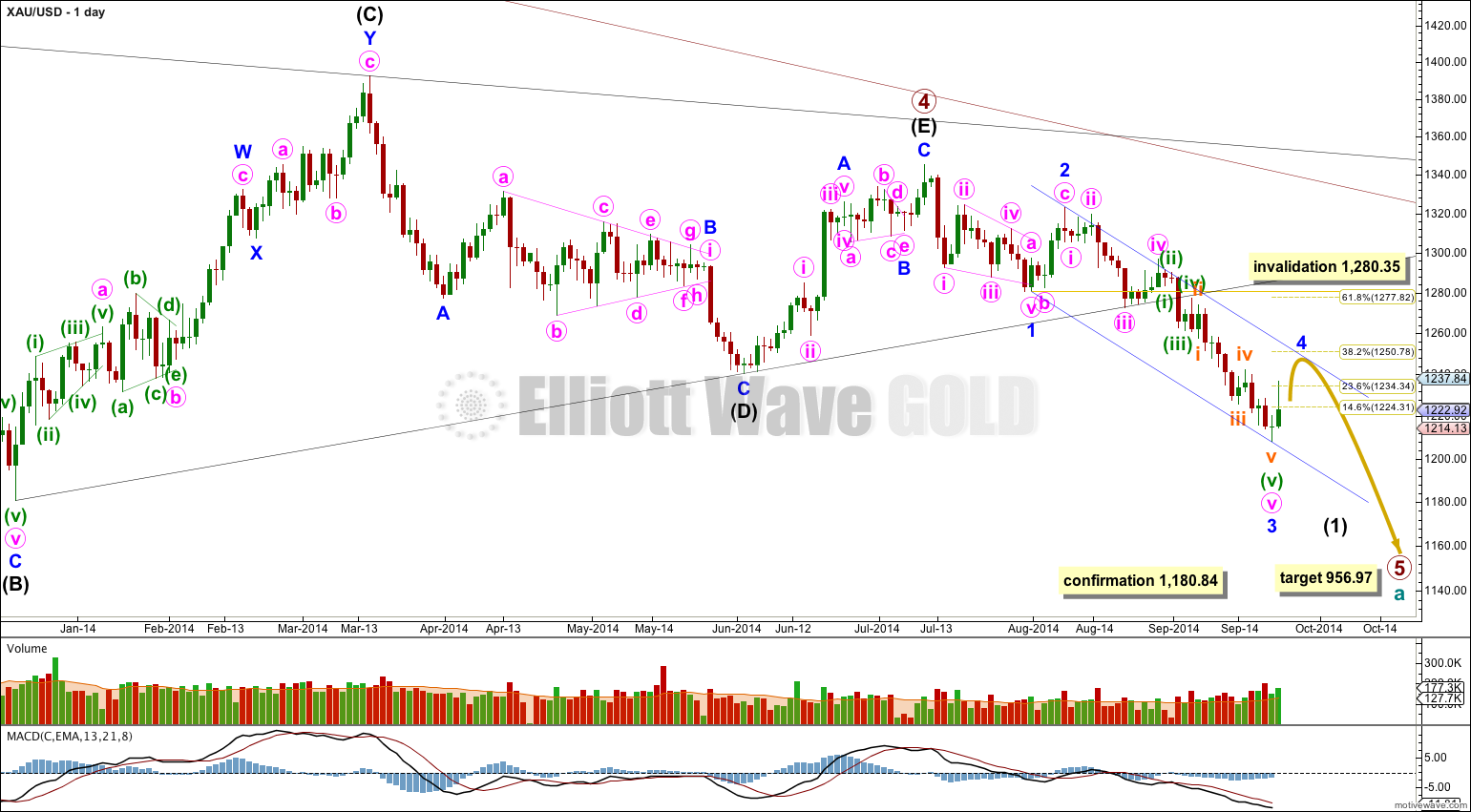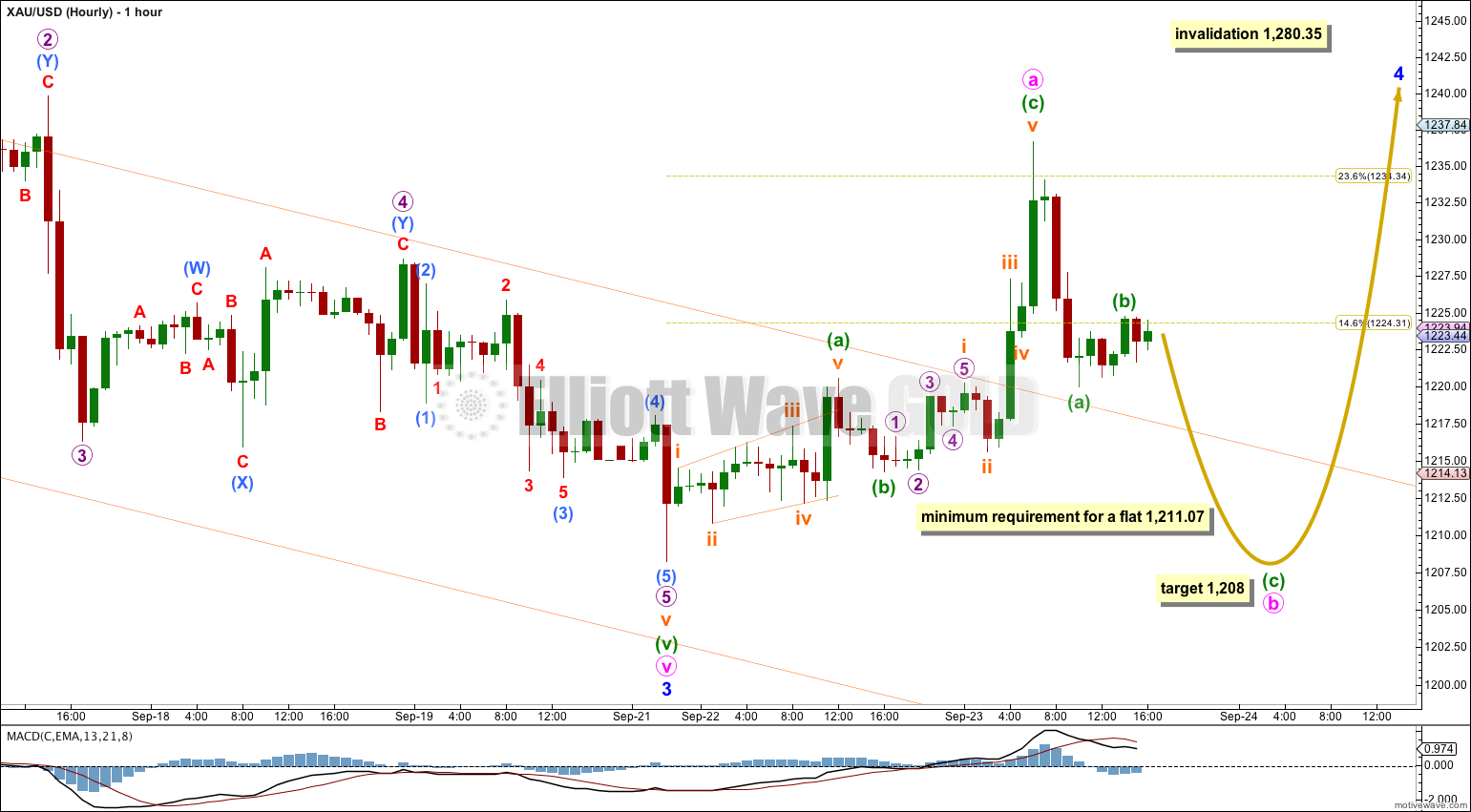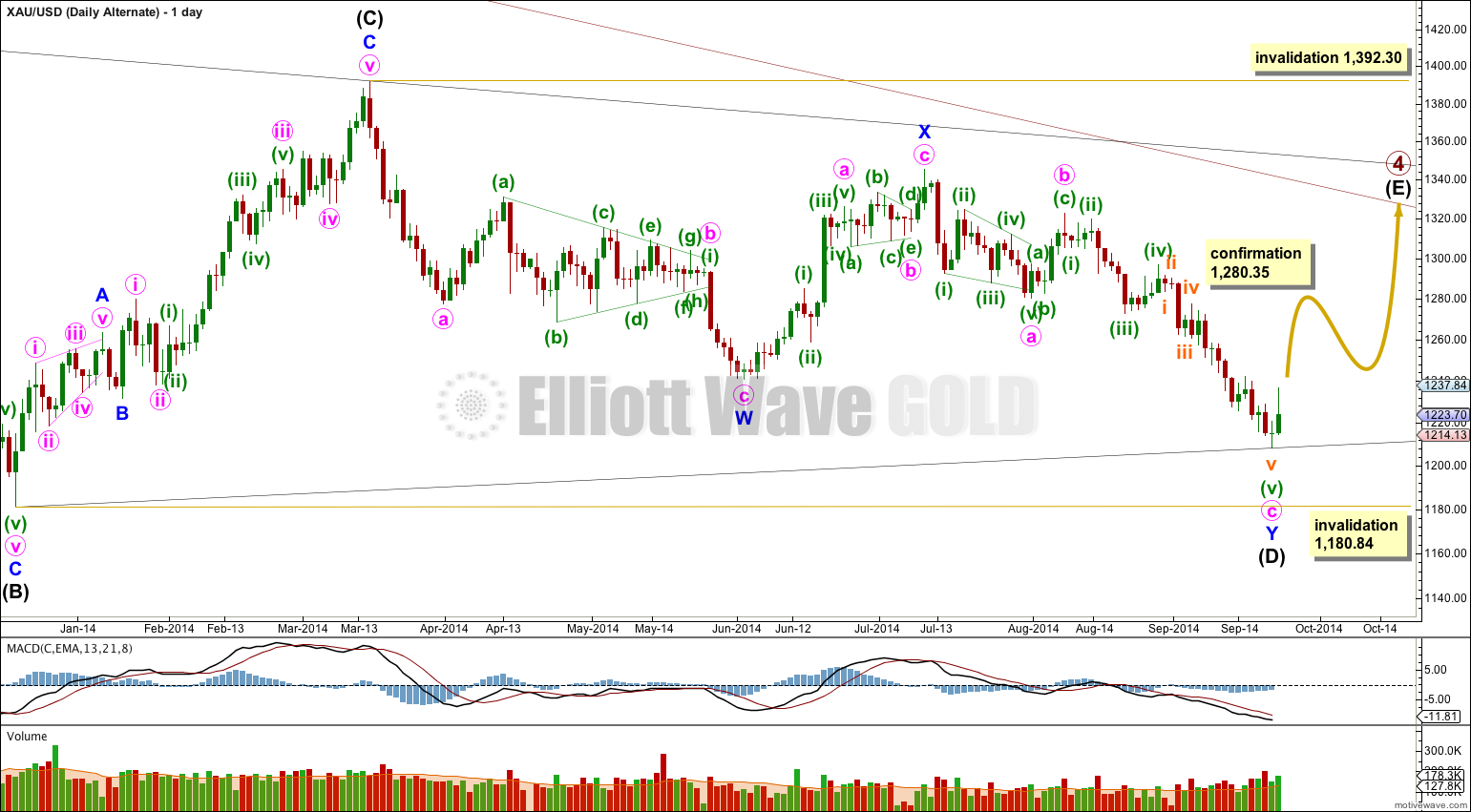Upwards movement for Tuesday was expected. Movement above the channel on the hourly chart and above 1,228.67 provided confirmation of the Elliott wave count.
Summary: Minor wave 4 has begun. Gold has moved into a consolidation phase which should last at least one week or maybe up to two weeks in total. Minor wave 4 is most likely to end about 1,250.78 (but may include a new low below 1,208.22 within it) and should be very choppy and overlapping. The Elliott wave count for structure within minor wave 4 will have to change as the structure unfolds.
Click on charts to enlarge.
Main Wave Count
Extend the triangle trend lines of primary wave 4 outwards. The point in time at which they cross over may be the point in time at which primary wave 5 ends. This does not always work, but it works often enough to look out for. It is a rough guideline only and not definitive. A trend line placed from the end of primary wave 4 to the target of primary wave 5 at this point in time shows primary wave 5 would take a total 26 weeks to reach that point, and that is what I will expect. Primary wave 4 has begun its 11th week.
The black (B)-(D) trend line is now clearly breached on the daily chart, and also clearly breached on the weekly chart. This is significant.
At 956.97 primary wave 5 would reach equality in length with primary wave 1. Primary wave 3 is $12.54 short of 1.618 the length of primary wave 1, and equality between primary waves 5 and 1 would give a perfect Elliott relationship for this downwards movement.
However, when triangles take their time and move close to the apex of the triangle, as primary wave 4 has (looking at this on a weekly chart is clearer) the movement following the triangle is often shorter and weaker than expected. If the target at 956.97 is wrong it may be too low. In the first instance I expect it is extremely likely that primary wave 5 will move at least below the end of primary wave 3 at 1,180.40 to avoid a truncation. When intermediate waves (1) through to (4) within primary wave 5 are complete I will recalculate the target at intermediate degree because this would have a higher accuracy. I cannot do that yet; I can only calculate it at primary degree.
Minor wave 3 is 9.65 longer than 1.618 the length of minor wave 1. This variation is less than 10% the length of minor wave 3 and so I would consider it an acceptable Fibonacci ratio. Just.
Movement comfortably below 1,180.84 would invalidate the alternate daily wave count below and provide further confidence in this main wave count.
I have drawn a Fibonacci retracement the length of minor wave 3. Minor wave 4 has already reached up to the 0.236 at 1,234.34, and may yet move higher to the 0.382 at 1,250.78 Fibonacci ratio, so that there is alternation with the deep correction of minor wave 2. I expect this tendency to alternation may be stronger than a tendency for corrections following fifth wave extensions to reach up to the end of the second wave within the extended fifth wave.
Draw a channel about intermediate wave (1): draw the first trend line from the lows labeled minor waves 1 to 3, then place a copy on the high labeled minor wave 2. Minor wave 4 may find resistance and may end about the upper edge of this blue channel. This indicates minor wave 4 could last only one week / 5 days.
The first upwards wave so far subdivides as a three, a zigzag. This means that we may see a new low shortly. When an A wave subdivides as a three then the possible corrective structures unfolding are a flat, triangle or combination. All of these structures may include new price extremes beyond their starts.
It is possible that minute wave a within minor wave 4 could be complete as a zigzag. Minor wave 4 may be a flat or a triangle. If minor wave 4 is a flat correction then within it minute wave b must reach a minimum 90% of minute wave a at 1,211.07.
At 1,208 minuette wave (c) would reach equality in length with minuette wave (a). Minute wave b may make a new low below the start of minute wave a at 1,208.22.
If minor wave 4 is a triangle minute wave b within it has no minimum requirement, and only needs to subdivide as a three.
Alternate Hourly Wave Count
By moving the degree of labeling within this first upwards wave all down one degree minute wave a may be incomplete, and may be unfolding as a double zigzag or double combination.
Within a double zigzag or double combination there is no minimum requirement for the depth of minuette wave (x). Minuette wave (x) may subdivide as any corrective structure. At 1,214 subminuette wave c would reach 0.618 the length of subminuette wave a. Minuette wave (x) may make a new low below 1,208.22, and if a double combination is unfolding this is entirely possible.
If minute wave a completes as a double zigzag or double combination this may be the A wave of a flat or triangle for minor wave 4.
Alternate Wave Count
I would judge this wave count to have a very low probability only because of proportion between primary waves 2 and 4. The main wave count sees them almost exactly of the same duration, with primary wave 2 lasting 53 weeks and primary wave 4 lasting 54 weeks. This alternate would see primary wave 4 as much longer in duration than primary wave 2. It is the proportion between second and fourth waves within an impulse which gives the wave count what is called the “right look”. This alternate would still have the right look, but it would not look as good as the main wave count.
If intermediate wave (D) continued further it could only be as a double zigzag. For a contracting triangle intermediate wave (D) may not move beyond the end of intermediate wave (B) below 1,180.84. For a barrier triangle intermediate wave (D) should end about the same level as intermediate wave (B), as long as the (B)-(D) trend line is essentially flat. In practice this means that intermediate wave (D) could end slightly below 1,180.84 and the wave count would remain valid. Unfortunately, this invalidation point is not black and white.
If intermediate wave (D) is a double zigzag, then intermediate wave (C) must be seen as a single zigzag because only one of the five subwaves of a triangle may be a double.
It is possible to see intermediate wave (C) as a zigzag, but to do so a rather obvious triangle must be ignored after the end of minor wave A. The main wave count sees a triangle in that position. I think this reduces the probability of this alternate.
Within intermediate wave (C) the subdivision within minuette wave (i) of minute wave iii of minor wave C is problematic. On the hourly chart this upwards wave subdivides as a double zigzag and does not fit well at all as a five wave structure. This is another reason why I would prefer a wave count which sees a triangle in that position because the subdivisions of those waves fit a triangle perfectly. This further reduces the probability of this alternate.
This alternate wave count does not diverge from the main wave count at this stage, and will not diverge for another one or two weeks. The main wave count expects upwards movement for minor wave 4 and this alternate wave count expects upwards movement for intermediate wave (E). If price moves above 1,280.35 then the main wave count would be invalidated and this alternate confirmed.
Intermediate wave (E) of a contracting or barrier triangle may not move beyond the end of intermediate wave (C) at 1,392.30.
This analysis is published about 05:08 p.m. EST.





Not Daily charts. Lara at the bottom of your Hourly charts it used to have the date and only one time i.e. Sep-16 12:00 and starting with yesterday’s Hourly charts the very bottom line has 4 times for each day i.e. Sept-24 4:00 8:00 12:00 16:00.
This should help as to when during the day the forecasted waves actions may happen.
Lara – A Gigantic Thank you for adding the times to your daily charts 4:00 8:00 12:00 16:00. Although it may appear to be a simple change. It probably requires extra accuracy in several ways on your part and should make a big potential difference in increased trading accuracy and trading profits.
One Thousand Thank Yous for doing that.
As usual you are the Einstein of Elliott Wave, The Best Elliott Wave forecaster in the world. We are so lucky to have your detailed daily written and video forecasts and Amazing charts worth their weight in gold 100 times over. In my mind you have no competition at your expert level.
Thanks Richard, but…..
I’m completely confused.
I’m looking at my daily chart and I can’t see any times? Only dates? I did not actually do anything different regarding time, at least not consciously on purpose.
I may have done something accidentally, in which case if I know what it is I’ll keep doing it.
Or maybe I just don’t understand what it is you’re pointing out here?
Please could you be very specific about what chart, what times… once I know what it is I’ve done that makes you so happy I can ensure I keep doing it.
I’m looking at yesterdays daily chart and I see no 8:00, 12:00 or 16:00 on it…